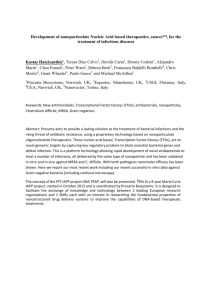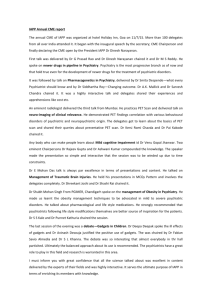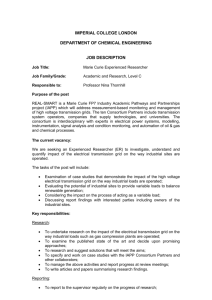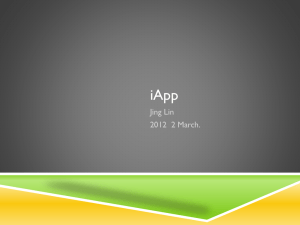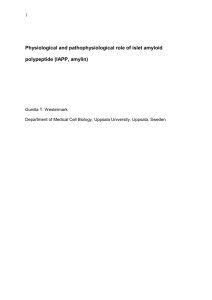00648F-What-should-be-in-an-IAPP
advertisement
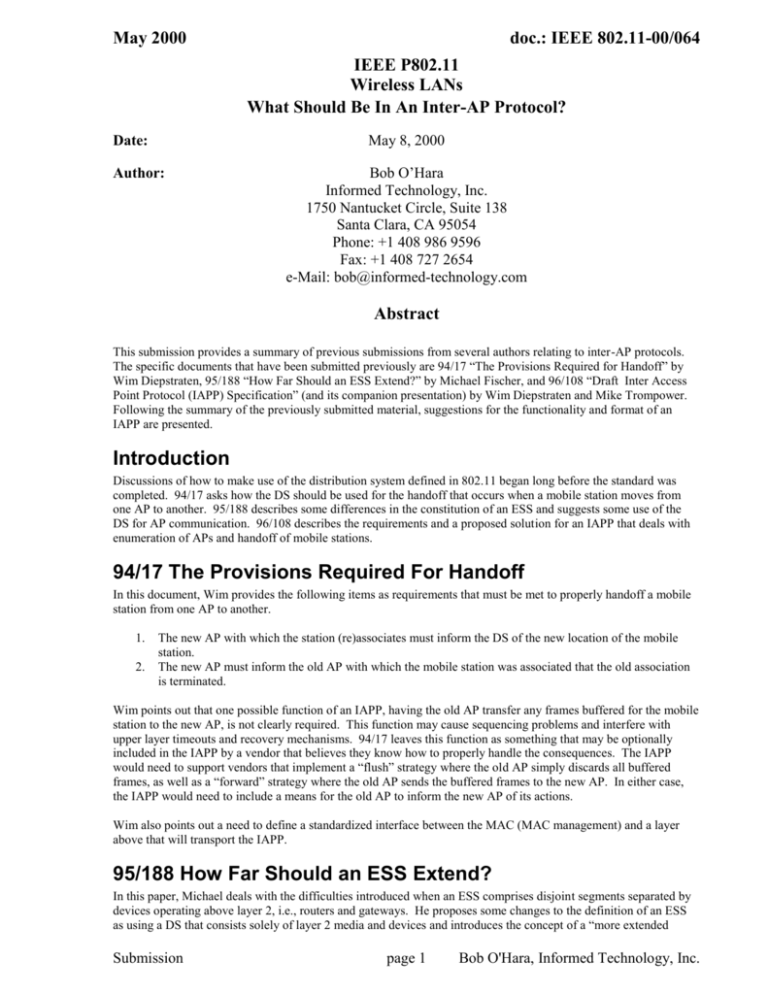
May 2000 doc.: IEEE 802.11-00/064 IEEE P802.11 Wireless LANs What Should Be In An Inter-AP Protocol? Date: May 8, 2000 Author: Bob O’Hara Informed Technology, Inc. 1750 Nantucket Circle, Suite 138 Santa Clara, CA 95054 Phone: +1 408 986 9596 Fax: +1 408 727 2654 e-Mail: bob@informed-technology.com Abstract This submission provides a summary of previous submissions from several authors relating to inter-AP protocols. The specific documents that have been submitted previously are 94/17 “The Provisions Required for Handoff” by Wim Diepstraten, 95/188 “How Far Should an ESS Extend?” by Michael Fischer, and 96/108 “Draft Inter Access Point Protocol (IAPP) Specification” (and its companion presentation) by Wim Diepstraten and Mike Trompower. Following the summary of the previously submitted material, suggestions for the functionality and format of an IAPP are presented. Introduction Discussions of how to make use of the distribution system defined in 802.11 began long before the standard was completed. 94/17 asks how the DS should be used for the handoff that occurs when a mobile station moves from one AP to another. 95/188 describes some differences in the constitution of an ESS and suggests some use of the DS for AP communication. 96/108 describes the requirements and a proposed solution for an IAPP that deals with enumeration of APs and handoff of mobile stations. 94/17 The Provisions Required For Handoff In this document, Wim provides the following items as requirements that must be met to properly handoff a mobile station from one AP to another. 1. 2. The new AP with which the station (re)associates must inform the DS of the new location of the mobile station. The new AP must inform the old AP with which the mobile station was associated that the old association is terminated. Wim points out that one possible function of an IAPP, having the old AP transfer any frames buffered for the mobile station to the new AP, is not clearly required. This function may cause sequencing problems and interfere with upper layer timeouts and recovery mechanisms. 94/17 leaves this function as something that may be optionally included in the IAPP by a vendor that believes they know how to properly handle the consequences. The IAPP would need to support vendors that implement a “flush” strategy where the old AP simply discards all buffered frames, as well as a “forward” strategy where the old AP sends the buffered frames to the new AP. In either case, the IAPP would need to include a means for the old AP to inform the new AP of its actions. Wim also points out a need to define a standardized interface between the MAC (MAC management) and a layer above that will transport the IAPP. 95/188 How Far Should an ESS Extend? In this paper, Michael deals with the difficulties introduced when an ESS comprises disjoint segments separated by devices operating above layer 2, i.e., routers and gateways. He proposes some changes to the definition of an ESS as using a DS that consists solely of layer 2 media and devices and introduces the concept of a “more extended Submission page 1 Bob O'Hara, Informed Technology, Inc. May 2000 doc.: IEEE 802.11-00/064 service set (MESS)” that includes a DS that may incorporate devices of any layer. Michael also points out that standardizing an IAPP would be a fruitful area to enhance multivendor interoperability. 96/108 Draft Inter-Access Point Protocol (IAPP) Specification This submission from Wim and Mike Trompower provides a detailed description of a set of functions that should be included in an IAPP, as well as a very flexible format for carrying the information. The functions described for an IAPP in this submission include the following. 1. Announcement of AP capabilities and configuration. 2. Identification of active APs. 3. AP “heartbeat”. 4. Provide coordinated management of APs. 5. Inform the “old AP” that a station has reassociated. 6. Update any layer 2 devices when a station associates with an AP. 7. Allow for proprietary extensions to the IAPP. The submission also explicitly excludes resolving addressing issues across subnet boundaries. The submission defines two protocols to implement the functions of the IAPP, an announce protocol and a handover protocol. The announce protocol is used to implement the coordination of APs and their management. The handover protocol is used update the APs with the current location of mobile stations and to update forwarding tables in any layer 2 devices (bridges). The announce protocol exchanges information between APs that allow for great flexibility in the configuration of the management function of the APs. The announce protocol can be used to implement both a centralized management scheme and a fully distributed management scheme. In addition, the protocol can be used simply as an announcement of AP state and configuration, without any management functionality, at all. The handover protocol is described as interacting with the station’s reassociation process. The reassociation request from the station initiates a handover request from the new AP to the old AP. During this process, any intervening bridges will be reconfigured to forward frames for the reassociating station to the new AP. The flexibility of the IAPP comes from the use of the same information element data structure as is used in MAC management. This submission defines 13 information elements. The elements are shown in the table, below. ID (hex) Name Description Data field Length Data (hex) 00-7F 00 01 02 03 04 05 06 07 1-33 6 6 6 1 2 2 2 string hex string hex string hex string bit significant ksec seconds ksec 10 11 12 13 1 1 1 2 see 96/108 see 96/108 see 96/108 ksec PHY-Type Regulatory-Domain Channel Beacon-Interval 80-FF 80 3 byte string Reserved for proprietary elements IEEE OUI company identifier Generic standard elements ESSID BSSID OLD BSSID MS-Address IAPP Capability / Status Periodic Announce Interval Station Staleout Time Handover Time-out The OUI element (ID=80) is used to preface a string of proprietary elements from the company identified by the value of the OUI element. Submission page 2 Bob O'Hara, Informed Technology, Inc. May 2000 doc.: IEEE 802.11-00/064 Today’s IAPP Given that each of the three submissions relating to an IAPP as several years old and a lot of experience has been gained using 802.11 systems in those years, what should be included in an IAPP today? It is my belief that much of what was described in 94/17 and 96/108 still applies. I also believe that there is more that could be incorporated into a “standard” IAPP than what has been presented before. The minimum functionality that should be in an IAPP is the handover capabilities described in 96/108. This would allow all vendors of 802.11 APs to operate consistently in a multi-vendor environment. Beyond the handover capability, I don’t believe that there are any functions that are strictly necessary for inclusion in an IAPP. However, there are other capabilities that can be of significant usefulness. The AP management capabilities included in the announcement protocol of 96/108 provide a simple means to enumerate the APs in an ESS and to manage some of their basic capabilities. This would be a significant boon to the configuration and operation of a multi-vendor WLAN. This management capability can be made more useful, if the parameters that may be configured are extended to include all of those commonly used by an AP. Complete configuration of an AP for operation straight from the box, without user intervention, could be a goal worth seeking. The AP “heartbeat” function described in 96/108 could be useful, if there were a mechanism to notify a management station. Unfortunately, the notification functionality is not defined. It seems to me that this function is better incorporated into standard monitoring utilities rather than the IAPP. Summary The task of creating a recommended practice for an IAPP can be very simple and straightforward, if the functionality is kept to the minimum handover capabilities. Even if AP management capabilities are added to the IAPP, the task becomes only slightly more complex. Submission page 3 Bob O'Hara, Informed Technology, Inc.
